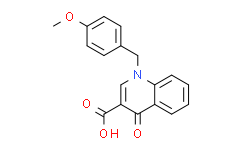| Cas No.: | 338747-41-4 |
| Chemical Name: | 1-(4-Methoxybenzyl)-4-oxo-1,4-dihydroquinoline-3-carboxylic acid |
| Synonyms: | 1-(4-methoxybenzyl)-4-oxo-1,4-dihydroquinoline-3-carboxylic acid;BQCA;1-[(4-methoxyphenyl)methyl]-4-oxoquinoline-3-carboxylic acid;1-(4-methoxybenzyl)-4-oxo-1,4-dihydro-3-quinolinecarboxylic acid;AC1LRSH3;CHEMBL608112;CTK8F8329;Oprea1_185678;SureCN1549479;Benzyl quinolone carboxylic acid;AK120609;BZBBTGCKPRSPGF-UHFFFAOYSA-N;MLS000755157;HMS2641J10;BCP20645;BQCA, >=98% (HPLC);BDBM50313638;s5931;BN0815;3996AB;SMR000338032;AX8246025;ST24 |
| SMILES: | O=C1C(C(=O)O[H])=C([H])N(C2=C([H])C([H])=C([H])C([H])=C21)C([H])([H])C1C([H])=C([H])C(=C([H])C=1[H])OC([H])([H])[H] |
| Formula: | C18H15NO4 |
| M.Wt: | 309.3160 |
| Purity: | >98% |
| Sotrage: | 2 years -20°C Powder, 2 weeks 4°C in DMSO, 6 months -80°C in DMSO |
| Description: | BQCA a highly selective allosteric modulator of the M1 mAChR. |
| In Vivo: | BQCA requires M1 to promote inositol phosphate turnover in primary neurons and to increase c-fos and arc RNA expression and ERK phosphorylation in the brain. BQCA reverses scopolamine-induced memory deficits in contextual fear conditioning, increases blood flow to the cerebral cortex, and increases wakefulness while reducing delta sleep. BQCA induces β-arrestin recruitment to M1, suggesting a role for this signal transduction mechanism in the cholinergic modulation of memory[1]. BQCA increases firing of mPFC pyramidal cells in vivo. BQCA also restores discrimination reversal learning in a transgenic mouse model of Alzheimer's disease[2]. |
| In Vitro: | BQCA reduces the concentration of ACh required to activate M1 up to 129-fold with an inflection point value of 845 nM. No potentiation, agonism, or antagonism activity on other mAChRs is observed up to 100 μM[1]. BQCA increases M1 receptor affinity for acetylcholine. The activation of the M1 receptor by BQCA induces a robust inward current and increases spontaneous excitatory postsynaptic currents in medial prefrontal cortex (mPFC) pyramidal cells[2]. |
| Kinase Assay: | Competition binding reactions used 25 μg human M1 CHO membrane protein, BQCA or vehicle, and 0.15 nM [3H]NMS in 96-well deep-well plates. Binding reactions (30 °C for 2-3 h) are terminated by rapid filtration. Nonspecific binding is determined by adding 10 μM atropine. Filter plates are ished 4×with ice-cold 20 mM HEPES, 100 mM NaCl, and 5 mM MgCl2, pH 7.4 using a 96-well harvester. Plates are dried and radioactivity counted with a microplate scintillation counter[1]. |
| Animal Administration: | Rats: Male Sprague-Dawley rats weighing 225-250 g, are injected i.p. with the micro-suspension (containing 10% tween 80) of BQCA at the dose of 10 mg/kg. The blood and whole brain tissue samples are collected at 0.5, 1, 2, 4 and 8 h. Blood samples are collected through cardiac puncture in EDTA vacutainer tubes. The plasma is separated by centrifugation and stored at −80°C until analysis. The animals are decapitated and the whole brain tissue are removed and immediately frozen on dry ice[2]. Mice: Mice are dosed I.P. with BQCA in 5% beta-cyclodextrin and/or 0.3 mg/kg scopolamine in 0.9% saline 30 min before placement into a chamber for 2 min before 2 tone-footshock pairings (3 kHz, 85 dB tone for 30 s co-terminated with a 0.5 mA, 1 s shock) 2 min apart. Mice are removed to their home cage 30 s after the last pairing. Twenty-four hours later mice are placed into the same chamber and freezing is measured by Video Freeze[1]. |
| References: | [1]. Ma L, et al. Selective activation of the M1 muscarinic acetylcholine receptor achieved by allosteric potentiation. Proc Natl Acad Sci U S A. 2009 Sep 15;106(37):15950-5. [2]. Shirey JK, et al. A selective allosteric potentiator of the M1 muscarinic acetylcholine receptorincreases activity of medial prefrontal cortical neurons and restores impairments in reversal learning. J Neurosci. 2009 Nov 11;29(45):14271-86. |

 To enhance service speed and avoid tariff delays, we've opened a US warehouse. All US orders ship directly from our US facility.
To enhance service speed and avoid tariff delays, we've opened a US warehouse. All US orders ship directly from our US facility.




















